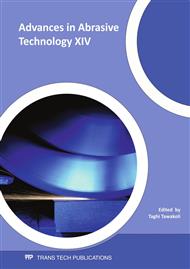p.201
p.208
p.213
p.219
p.225
p.231
p.238
p.244
p.251
3-D CFD Parametric Study of the Impact of the Fluid Properties and Delivery Conditions on Flow and Heat Transfer in Grinding
Abstract:
Fluids have an important role in grinding. Correct fluid application results in enhanced process stability, better work piece quality, and tool life. This paper shows that Computational Fluid Dynamics (CFD) models can be used to simulate the fluid flow and heat transfer in a grinding process, replacing numerous experiments that are expensive, time-consuming, and have limited capabilities. The most important properties of created 3-D model are described, along with results obtained. The results show very detailed distributions of temperatures, pressures, and flow rates in and around the grinding region. The data obtained is essential in studying the influence of the grinding fluid on the grinding process, as well as in determining the best fluid composition and supply parameters for a given application. The results agree well with experimental global flow rates and temperature values and show the feasibility of 3-D CFD-based simulations in grinding applications. The parametric studies of influence of several fluid physical properties on useful flow rates and temperatures were presented as well.
Info:
Periodical:
Pages:
225-230
Citation:
Online since:
August 2011
Authors:
Price:
Сopyright:
© 2011 Trans Tech Publications Ltd. All Rights Reserved
Share:
Citation:


